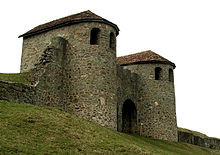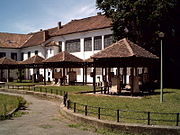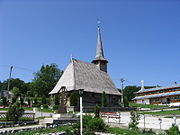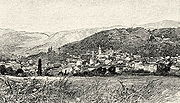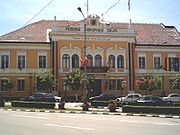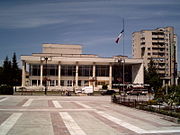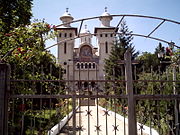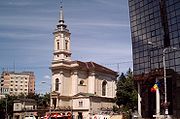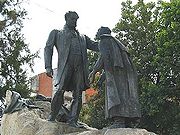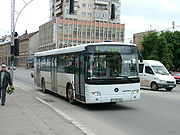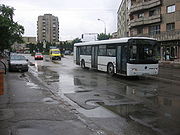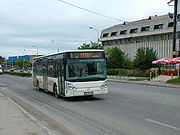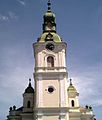- Zalău
-
Coordinates: 47°11′N 23°3′E / 47.183°N 23.05°E
Zalău — County seat — 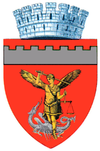
Coat of armsLocation of Zalău
Coordinates: 47°11′28″N 23°3′26″E / 47.19111°N 23.05722°E Country  Romania
RomaniaCounty Sălaj County Status County seat Government - Mayor Radu Căpâlnaşiu (National Liberal Party (Romania)) Area - Total 90.09 km2 (34.8 sq mi) Population (2006) - Total 64,648 - Density 698/km2 (1,807.8/sq mi) Time zone EET (UTC+2) - Summer (DST) EEST (UTC+3) Website http://www.zalausj.ro/ 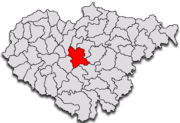 Zalău within Sălaj County
Zalău within Sălaj County
Zalău (Romanian pronunciation: [zaˈləw]; German: Zillenmarkt or Waltenberg, Hungarian: Zilah) is the seat of Sălaj County, Transylvania, Romania. In 2004, its estimated population was 62,900.
Contents
History
Ancient times
Zalău is situated in the area inhabited by "Free Dacians", 8 kilometers away from the historical landmark of Porolissum, a well-preserved Roman Castrum with an imposing fortress, an amphitheater, temples, houses and a customs house in the ancient Roman province of Dacia. Zalău was the crossing point between Central Europe and Transylvania, along the so-called "Salt Route".
Archaeological discoveries revealed evidence of human existence in this area since the Neolithic, approx. 6500 years ago. Dacian coins found in archaeological perimeters of the city central area and on the Valea Mâții, west of the city, plus important items belonging to Roman culture, are evidence of free Dacian continuity in this area and of developing economic relations with the Roman ancient city of Porolissum.
After the conquest of Dacia by Trajan (106), the Roman Empire border stood atop the Meses Mountains, just 5 Km away from the city. Just north from the border, on the actual Zalău city area were the free Dacians tribes, and to the east, south-east (of Meses Mountains) were Roman border fortifications, towers, walls, ditches and defense sides.
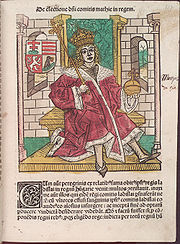 On 1 August 1473, Matthias Corvinus certified Zalău as a town, "Oppidum Zilah".
On 1 August 1473, Matthias Corvinus certified Zalău as a town, "Oppidum Zilah".
 Ady Endre attended school in Zalău
Ady Endre attended school in Zalău
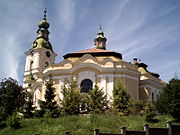 Reformed church (1904-07)
Reformed church (1904-07)
Middle Ages
The first written mention about Zalău, was in the "Gesta Hungarorum", also called the "Chronicle of Anonymous" (probably notary of the King Béla III of Hungary), published around year 1200. According to this source, Zalău settlement would have been there as early as around 900. Later, Zalău is referred to as Villa Ziloc in 1220, Zylac in 1246, Zylah in 1282, Zyloh and oppidum Zylah in 1318, Zila in 1601, Zilahu in 1808, Sziláj / Szilágyi in 1839, Szilaju in 1850, and Zalău / Sziláju / Walthenberg in 1854. After the great Mongol invasion, which destroyed the city in 1241, Zalău came in 1246 under the administration of the Catholic Bishopric of Oradea. The trusteeship was maintained until 1542, when Zalău became part of Principality of Transylvania.
On August 1, 1473 Matthias Corvinus, king of Hungary and Bohemia, acknowledged Zalău as a market town for the first time (called oppidum Zilah - Zilah fort), a privilege that freed the city from the county domination, granted its citizens the right of free trade and gave it a larger degree of economic autonomy.
At the end of the XVI century, the city had an independent administrative leadership, composed of 33 elected senators (one of whom was the mayor), a notary, a registrar and a treasurer.
Other important events in the development of the city occurred in 1571 during the reign of Prince Istvan Bathory and in 1600 under the reign of Michael the Brave. After Transylvania had been annexed to the Habsburg Empire, the city experienced an economic decline due to infusion of products from the Western Europe.
After Michael the Brave's victory at Guruslău on August 3rd 1601, Zalău received administrative, legislative, fiscal and military own rules, which provided real autonomy freedoms to citizens. A chronicle from the seventeenth century, first mentioned the main crafts of city residents: belt-makers, potters, wheelwrights, shoemakers, butchers, tailors, blacksmiths, carpenters, hat makers and armorers.
The city was under the rule Principality of Transylvania between 1526-1660. It was also controlled by the Ottomans between 1660-1692.
Modern times
Before the Treaty of Trianon, Zalău was one of the most important urban centers in the region. It had a Reformed, a college (Wesselényi college), a township school for civil service (for boys only), and a national civil school (for girls only). It had the largest hospital in the region and a tax revenue office.[citation needed]
In 1850, its population was 4,294 and, in 1910—8,062 (7,477 Hungarians, 19 Germans, 529 Romanians and 23 belonging to other ethnic groups). By religion, there were 1,333 Roman Catholics, 873 Greek-Catholics, 5,363 members of the Reformed Church, and 415 Jews. The city had 1,427 households, and most of its inhabitants were working in manufacturing. The Reformed church was built in 1246. It is one of the city's oldest buildings and one of the largest in Eastern Europe. In 1711, Charles XII of Sweden rested one night in a building on Király street (now named after Corneliu Coposu).
Between 1892-1896, one of the most famous Hungarian poets Endre Ady attended the Protestant school in Zalău (since 1957 there is a statue of Endre Ady in the front of the school). The poet also published his first poem in the local newspaper "Szilágy" on March 22, 1896.
In 1876, Zalău became the seat of the Szilágy County. Since 1918 it has been part of Romania - except between 1940-1944 when Northern Transylvania was under the Hungarian rule after the Second Vienna Award.
It was after 1960s when the city became a regional industrial center for the first time. During the communist regime, industrial factories like Armătura Zalău, Silcotub Zalău and Anvelope Silvania (bought recently by Michelin) hired thousands of workers, which also sparked an increase in population. The Romanian communist regime saw that thousands of Romanians from the South[clarification needed] were brought and established into the region in an effort to uproot and outnumber the Hungarian majority population[citation needed] - this was in effect a form of ethnic cleansing[citation needed] and had the desired result: the Hungarian-Romanian population ratio is nowadays completely changed from what it used to be in the past, with the Romanians being now the majority and the Hungarians reduced to the minority. However, in the surrounding countryside this artificial Romanianization[citation needed] has failed. Many of the surrounding communes (for example Vârşolţ) are still populated in majority by Hungarians. This is the same for vast parts[which?] of Transylvania, and it is the same for the old German populations which were also effectively pushed out of the country by the Communists in the recent decades.
In the 1970s with the working-class population expanding, housing estates of high-rise blocks of flats were built in the centre as well as on the outskirts of the town. Many beautiful traditional buildings were destroyed and the town lost not only some of its architectural treasures but also its cultural identity. This sadly is once again the norm throughout most of Transylvania[citation needed], and is part of the region's all too common story of devastation and destruction brought by Communism.
Today Zalău is crossed by European road E81 and the national road DN 1F. A new motorway (Transylvania Highway) is being built to connect Zalău to Western Europe. The town has two nationally accredited University colleges, a public library, one museum, an art gallery, more than four hotels, a motel, and two student halls of residence.
Geography
Zalău lies in the Zalău Valley, at the junction of the Apuseni mountains and the Eastern Carpathians, in Sălaj County, at 47°12′N 23°3′E / 47.2°N 23.05°E. Zalău is in the central part of Sălaj County, in Zalău River watershed where the depression of the same name and the Meseş Peak meet.
It neighbours Ţara Maramureşului and the county of Satu Mare, in the northwestern part of the historical region of Transylvania, which in the past was a mainly independent small state but since 1918 has belonged to Romania. It lies along the bank of the small river Zalău, between three narrow valleys in the Meseş mountains. It is the county seat and the largest city in Sălaj County.
The city includes a total surface of 90.09 square km. This includes the one village it administers, Stâna (Felsőnyárló), situated south-east of Meseş, in the hydrographic basin of Agrij.
Sights
The most important of the 24 monuments and buildings in the county capital of Zalău are: "Transilvania" (theatre in 1895), the city hall (court and seat of the prefects office in 1889), the Roman Catholic Church (1878), the reformed church (1904–1907), the Greek Catholic church "Adormirea Maicii Domnului" (1930–1934), the Orthodox deanery (built in late 19th century), the Historical Museum (built about 1900 - casino of the artisans fellowship), the primary school "Simion Bărnuţiu" (girls' school in 1895) and the Mathematics-Physics high school (Reformed College in 1860), all these being valuable urbanistic elements for the historical and cultural patrimony of the land. The famous statuary group "Wesselényi" of the heroic Hungarian nobleman with the same name (1902) by János Fadrusz, and the bust made in the honour of Simion Bărnuţiu by Romul Ladea are worth visiting as well.
Zalău hosts lively pageants each year, including a summer festival known as the "Zalău Days". There is a statue of Baron Wesselényi in the town center; the Tuhutum Memorial (both made by János Fadrusz in 1902); the Zalău County Museum of History and Art displays artifacts ranging from neolithic times to modern times, with a focus on the Roman period and hosts works of modern art. There are several churches, including the Calvinist cathedral, which is one of the most beautiful and largest in Transylvania.
Population
The population of Zalău went through important evolutions throughout times (see above), and at present the data indicated by the census are the following: 62,927 inhabitants.
From an ethnical point of view according to the census in 2002 the population had the following structure: 80.89% Romanians, 17.50% Hungarians, 1.36% Gypsies, 0.25% others.
Historical populations Year Pop. ±% 1850 4,294 — 1880 5,961 +38.8% 1910 8,062 +35.2% 1930 8,340 +3.4% 1941 8,546 +2.5% 1948 11,652 +36.3% 1956 13,378 +14.8% 1966 14,380 +7.5% 1977 31,923 +122.0% 1992 68,404 +114.3% 2002 62,927 −8.0% 2004 64,648 +2.7% 2006 64,123 −0.8% 2007 63,642 −0.8% 2008 63,860 +0.3% 2010 64,178 +0.5% Ethnic structure
Total Romanians Hungarians Gypsies Other 1910 10,184 2,585 7,540 59 100 % 25.38 % 74.03 % 0.57 % 1930 10,688 4,364 5,624 140 560 100 % 40.84 % 52.61 % 1.30 % 5.23 % 1956 13,378 6,468 6,756 15 144 100 % 48.34 % 50.50 % 0.11 1.07 % 1977 31,923 22,076 9,665 83 99 100 % 69.15 % 30.27 % 0.26 % 0,31 % 1992 68,404 53,974 13,637 629 164 100 % 78.90 % 19.93 % 0.91 % 0.23 % 2002 62,927 50,902 11,016 858 151 100 % 80.89 % 17.50 % 1.36 % 0.23 % 2002:[1]
1992:
- Romanians 78.8%;
- Hungarians 20.1%;
- Other 1.1%
1910:
Confessional structure
Zalău confessional structure Confession 1930[3] 2002[4] Reformed Church in Romania 52.41 % 15.24 % Greek Catholics 18.98 % 3.07 % Roman Catholics 11.46 % 1.72 % Romanian Orthodox 6.01 % 73.29 % Jews 5.14 % < 0.1% Baptists 0.91 % 2.01 % Pentecostals < 0.1 % 3.29 % Etymology
The location had various names: "Ziloc" in 1220, "Oppidum Zilah" in 1473, "Zila" in 1601, and "Zilahu" and "Zalahu" in the 19th century, or forms of German toponimy "Waltenberg" and "Zillenmarkt".
Politics
At the end of the 16th century, the town had an independent administrative rule made of 33 elected senators, from whom one of them was the mayor. There were also a notary, an archivist and a treasurer.
Formed by 21 members, the Local Council has the following attributes: to approve the local budget, loans, credit transfers and the means of use of the budgetary reserve; it establishes local taxes as well as special taxes; to elect the vice-mayors, to decide on the staff of attendants number.
2008 elections
Mayor Radu Căpâlnaşiu was elected first time in 2004 as member of Democratic Party and re-elected in 2008 as member of National Liberal Party.
The Zalău Municipal Council, elected in the 2008 local government elections, is made up of 21 councilors, with the following party composition:
Party Seats 2008 Zalău Council National Liberal Party 9 Democratic Liberal Party 4 Social Democratic Party 4 Democratic Union of Hungarians in Romania 4 2004 elections
The Zalău Municipal Council, elected in the 2004 local government elections, is made up of 21 councilors, with the following party composition:
Party Seats 2004 Zalău Council National Liberal Party 5 Democratic Party 5 Social Democratic Party 6 Democratic Union of Hungarians in Romania 3 Greater Romania Party 2 Tourism
Sports
Zalău also had a great handball team, coached by Gheorghe Tadici until 2006, who is also the head coach of Romania's national handball team.
Notable residents
- Miklós Wesselényi (1796 - 1850), Hungarian statesman;
- Endre Ady (1877 - 1919), Hungarian poet;
- Iuliu Maniu (1873 - 1953), Romanian politician;
- Talida Tolnai (b. 1979), Romanian handball player;
- Ramona Farcău (b.1979), Romanian handball player.
International relations
Main article: List of twin towns and sister cities in RomaniaTwin towns — Sister cities
Zalău is twinned with:
Works
- János Kovács Kuruc, Zilah vallási életéről, In: Limes, 2000, 3, nr. 1-2, p. 138-143.
- Éva Lakóné Hegyi; Wagner, Ernő. A zilahi kalandosok, In: EM, 2001, 63, nr. 1-2, p. 30-41.
- Florin Mirgheşiu, Modernitatea Zalăului. In: AMPZ, 2001, 2, nr. 4, p. 11-19.
- Moroti, Elisabeta. Scurtă privire istorică asupra dezvoltării economice a oraşului Zalău. In: AMPZ, 2001, 2, nr. 4, p. 36-39.
- Municipiul Zalău. Prezentare. In: AMPZ, 2002, 3, nr. 7-8, p. 154-161.
- Elena Muscă, Meşteşugari zălăuani şi locul lor în structurile administraţiei publice locale, In: AMP, 2003, 25, p. 325-332.
- L. Nicoară; Puşcaş, Angelica. Rolul municipiului Zalău în zona de contact dintre depresiunea Transilvaniei şi Dealurile de Vest. In: Studia geogr., 1999, 44, nr. 1, p. 99-112.
References
- ^ 2002 census results
- ^ Atlas and Gazetteer of Historic Hungary 1914, Talma Kiadó
- ^ Recensământul general al populaţiei României din 29 Decemvrie 1930, vol. II, pag. 713.
- ^ http://recensamant.referinte.transindex.ro/?pg=3&id=2188
External links
- (Romanian) http://www.salaj.insse.ro/main.php
- (Romanian) and (English) http://www.insse.ro/cms/files/pdf/ro/cap2.pdf
Photos
Sălaj County, Romania Cities Zalău (county seat)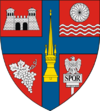
Towns Communes Agrij · Almaşu · Băbeni · Bălan · Bănişor · Benesat · Bobota · Bocşa · Boghiş · Buciumi · Camăr · Carastelec · Chieşd · Cizer · Coşeiu · Crasna · Creaca · Crişeni · Cristolţ · Cuzăplac · Dobrin · Dragu · Fildu de Jos · Gâlgău · Gârbou · Halmăşd · Hereclean · Hida · Horoatu Crasnei · Ileanda · Ip · Letca · Lozna · Măerişte · Marca · Meseşenii de Jos · Mirşid · Năpradea · Nuşfalău · Pericei · Plopiş · Poiana Blenchii · Românaşi · Rus · Sâg · Sălăţig · Şamşud · Sânmihaiu Almaşului · Sărmăşag · Şimişna · Someş-Odorhei · Surduc · Treznea · Valcău de Jos · Vârşolţ · Zalha · Zimbor
County seats of Romania (alphabetical order by county) Alba Iulia • Arad • Piteşti • Bacău • Oradea • Bistriţa • Botoşani • Braşov • Brăila • Buzău • Reşiţa • Călăraşi • Cluj-Napoca • Constanţa • Sfântu Gheorghe • Târgovişte • Craiova • Galaţi • Giurgiu • Târgu Jiu • Miercurea-Ciuc • Deva • Slobozia • Iaşi • Buftea • Baia Mare • Drobeta-Turnu Severin • Târgu Mureş • Piatra Neamţ • Slatina • Ploieşti • Satu Mare • Zalău • Sibiu • Suceava • Alexandria • Timișoara • Tulcea • Vaslui • Râmnicu Vâlcea • Focşani
Bucharest (national capital) Categories:
Categories:- Cities in Romania
- Populated places in Sălaj County
Wikimedia Foundation. 2010.

